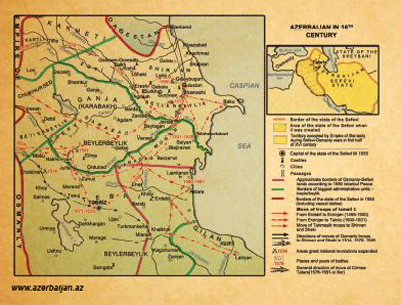"HEYDƏR ƏLİYEV İRSİ"
BEYNƏLXALQ ELEKTRON KİTABXANA
"HEYDAR ALIYEV HERITAGE"
INTERNATIONAL ONLINE LIBRARY
- Library is a holy temple for the people and nation, it is the source of knowledge, wisdom and spirituality
H. Aliyev
H. Aliyev
Azerbaijani state of Safavids
 In XVI century Azerbaijan was the socio-economic, political, cultural, and ideological center of the Safavid state (1501-1736). It included Azerbaijan, Iran, the Southern Turkmenistan, present-day Afghanistan (excluding the province of Balkh), the Arabian Iraq and other territories.The Azerbaijani Safavid state was founded by Shah Ismail I. Having received an excellent education, Ismail began his military and political activity since 1499, ascended to the throne in 1501 and turned his new state into a mighty empire. The name of the ruling Turkic dynasty of the state is connected with the name of Sheikh Safi-ad-din Ardabili, head of Safaviyya order. The capitals of the Safavid state were Tabriz (1501-1555), Gazwin (1555-1598) and Isfahan (since 1598). Its most socially, economically and culturally developed province was Azerbaijan. The Azerbaijani Qizilbash tribes (hence the Safavid state is sometimes named Qizilbash state) and the Ardabil feudals played a leading role in the government. Shah Tahmasib I, son of Shah Ismail I, continued the policy of unification of the Azerbaijani territories. In 1538, the Shirvanshah state was abolished and incorporated into the Safavids. In 1551, the territory of Shaki became part of the state. The Safavid state entered a period of deep economic and political decline at the end of XVII century. In the coronation ceremony held in Mughan in March 1736, Nader Afshar was proclaimed shah by the assembled feudals, thus, effectively ending the formal power of the Safavid dynasty.
In XVI century Azerbaijan was the socio-economic, political, cultural, and ideological center of the Safavid state (1501-1736). It included Azerbaijan, Iran, the Southern Turkmenistan, present-day Afghanistan (excluding the province of Balkh), the Arabian Iraq and other territories.The Azerbaijani Safavid state was founded by Shah Ismail I. Having received an excellent education, Ismail began his military and political activity since 1499, ascended to the throne in 1501 and turned his new state into a mighty empire. The name of the ruling Turkic dynasty of the state is connected with the name of Sheikh Safi-ad-din Ardabili, head of Safaviyya order. The capitals of the Safavid state were Tabriz (1501-1555), Gazwin (1555-1598) and Isfahan (since 1598). Its most socially, economically and culturally developed province was Azerbaijan. The Azerbaijani Qizilbash tribes (hence the Safavid state is sometimes named Qizilbash state) and the Ardabil feudals played a leading role in the government. Shah Tahmasib I, son of Shah Ismail I, continued the policy of unification of the Azerbaijani territories. In 1538, the Shirvanshah state was abolished and incorporated into the Safavids. In 1551, the territory of Shaki became part of the state. The Safavid state entered a period of deep economic and political decline at the end of XVII century. In the coronation ceremony held in Mughan in March 1736, Nader Afshar was proclaimed shah by the assembled feudals, thus, effectively ending the formal power of the Safavid dynasty.
